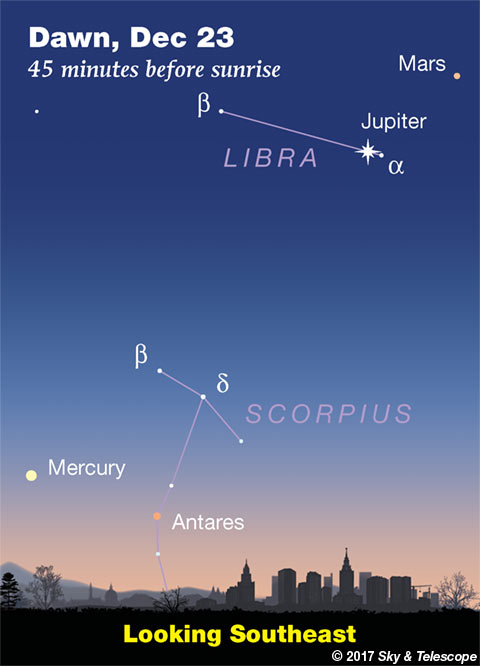
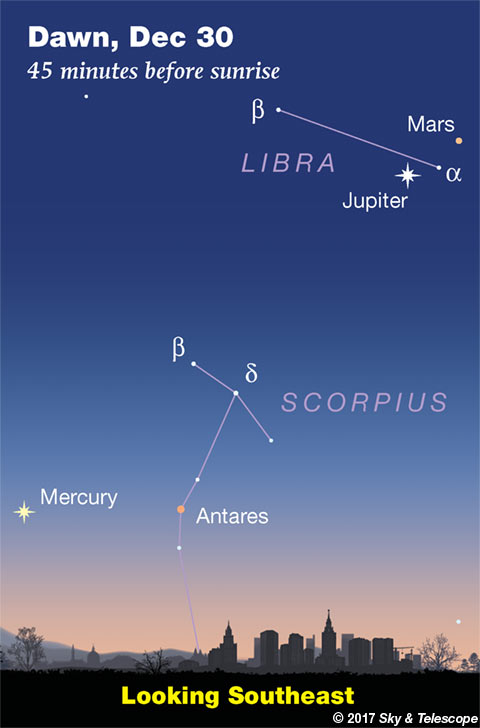
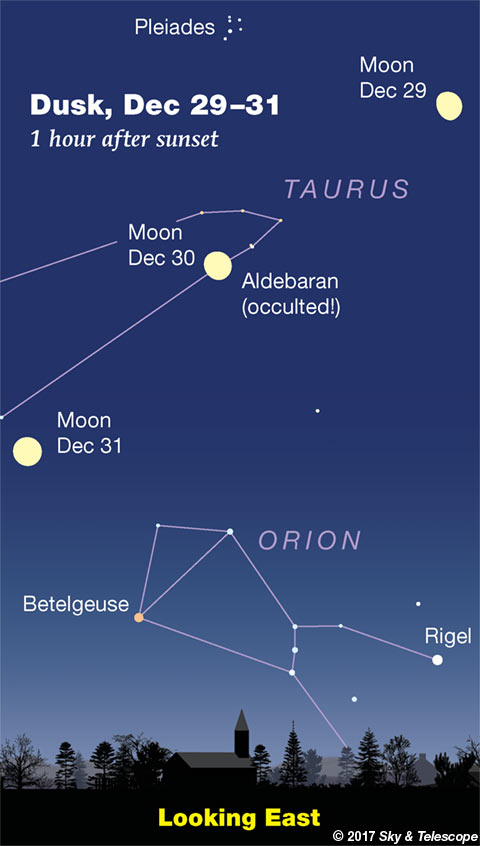
Friday, December 22
• As twilight fades away this evening, you'll find the waxing crescent Moon in the southwest. The Moon is less than halfway from Fomalhaut, far left of it, to Altair, farther right of it.
• Even with winter officially here, the big Summer Triangle remains up in the west after nightfall. Altair is the first of its stars to go. Start by spotting bright Vega in the northwest. The brightest star above Vega is Deneb. Altair is the Triangle's third star, farther to Vega's left or lower left. How late into the evening, and into the advancing winter, can you keep Altair in view?
Saturday, December 23
• Watch Sirius rise this evening! Find a spot with an open view smack down to the east-southeast horizon, and watch for Sirius to come up below Orion's vertical Belt, by about two fists at arm's length. Sirius rises around 7 or 8 p.m. now, depending on your location. When a star is very low, it tends to twinkle quite slowly and often in vivid colors. Sirius is bright enough to show these effects well, especially with binoculars.
• Sirius and Procyon in the balance. Once Sirius is up, look to its left (by about two fists at arm's length) for Procyon. If you live around latitude 30° north (Tijuana, New Orleans, Jacksonville), they'll be at the same height above your horizon soon after they rise. If you're north of that latitude, Procyon will be higher. If you're south of there, Sirius will be the higher of the two. The eastern edge of the Earth tilts differently depending on where you are!
• Algol should be at its minimum brightness for a couple hours centered on 8:00 p.m. EST.
Sunday, December 24
• As soon as the stars come out, look high above the Moon for the Great Square of Pegasus. Look far below the Moon for Fomalhaut.
Monday, December 25
• The Moon, now fattened to first quarter, shines in Pisces — about at the same place it always resides when it's first quarter on Christmas (think why).
Once the stars come out, you'll find the Great Square of Pegasus still above above the Moon. But, unlike yesterday, the eastern (left) side of the Square points down to the Moon (at nightfall for North America).
And look far lower right of the Moon now for Fomalhaut. As the "Autumn Star," Fomalhaut will soon slide down out of sight in the southwest.
Tuesday, December 26
• M31, the Andromeda Galaxy, passes your zenith right after the end of twilight now (if you live in the world's mid-northern latitudes). Binoculars will show M31 just off the knee of the Andromeda constellation's stick figure; see the big evening constellation chart in the center of Sky & Telescope.
Wednesday, December 27
• As the stars come out, face due north and look high. Cassiopeia is now a flattened "M" canted at about a 45° angle (depending on where you live). Hardly more than an hour later, the M has turned horizontal. Constellations passing near the zenith appear to rotate rapidly with respect to the direction "up."
Thursday, December 28
• Orion is already up in the east-southeast at nightfall. Above it glitters orange Aldebaran, 65 light-years away. Above Aldebaran are the Pleiades, about 435 light-years away. Far left of Aldebaran and the Pleiades, brilliant Capella shines from a distance of 42 light-years.
Friday, December 29
• This evening, look lower left of the waxing gibbous Moon for Aldebaran, and upper left of the Moon for the Pleiades.
• Mercury should be an easy catch now low in the dawn. Look for it far lower left of Jupiter, as shown in the middle scene above (their visibility as dawn grows bright is exaggerated there).
Saturday, December 30
• Watch the Moon pull eastward away from Aldebaran through the night. If you're in the eastern US, the Moon occults Aldebaran early this evening; in northern Europe the occultation happens very late in the night. Map and local timetables, including the times of the star's disappearance and reappearance for many locations and the altitudes of the Moon and Sun at those times. (Note that the text consists of three separate, long tables: for the star's disappearance, for its reappearance, and the locations of the cities.) With the Moon so bright, use a telescope.
________________________
Want to become a better astronomer? Learn your way around the constellations! They're the key to locating everything fainter and deeper to hunt with binoculars or a telescope.
This is an outdoor nature hobby. For an easy-to-use constellation guide covering the whole evening sky, use the big monthly map in the center of each issue of Sky & Telescope, the essential guide to astronomy.

Once you get a telescope, to put it to good use you'll need a detailed, large-scale sky atlas (set of charts). The basic standard is the Pocket Sky Atlas (in either the original or Jumbo Edition), which shows stars to magnitude 7.6.
Next up is the larger and deeper Sky Atlas 2000.0, plotting stars to magnitude 8.5; nearly three times as many. The next up, once you know your way around, is the even larger Uranometria 2000.0 (stars to magnitude 9.75). And read how to use sky charts with a telescope.
You'll also want a good deep-sky guidebook, such as Sue French's Deep-Sky Wonders collection (which includes its own charts), Sky Atlas 2000.0 Companion by Strong and Sinnott, or the bigger Night Sky Observer's Guide by Kepple and Sanner.
Can a computerized telescope replace charts? Not for beginners, I don't think, and not on mounts and tripods that are less than top-quality mechanically (meaning heavy and expensive). And as Terence Dickinson and Alan Dyer say in their Backyard Astronomer's Guide, "A full appreciation of the universe cannot come without developing the skills to find things in the sky and understanding how the sky works. This knowledge comes only by spending time under the stars with star maps in hand."
This Week's Planet Roundup
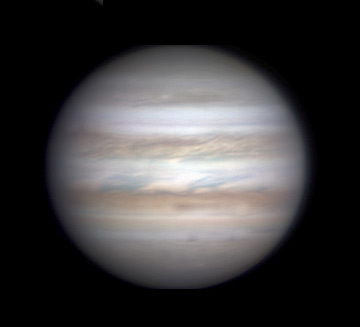
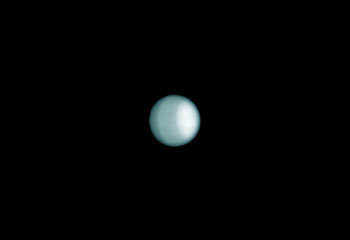
Mercury (magnitude 0) is having a good morning apparition. Look for it low in the southeast in early dawn, very far lower left of bright Jupiter. Don't confuse Mercury with fainter, twinklier Antares about 9° to its right.
Venus and Saturn are out of sight, hidden behind the glare of the Sun.
Mars and Jupiter (magnitudes +1.6, and –1.8, respectively) rise in the east-southeast around 3 to 4 a.m. First up is Mars, far to the lower right of Spica. Then Jupiter, much brighter, rises much closer to Mars's lower left. By early dawn they're well up in the southeast.
The gap between Mars and Jupiter is closing: from 6½° on the morning of December 23rd to 3½° on the 30th. They'll have a close conjunction, 0.3° apart, on the mornings of January 6th and 7th.
Close to Jupiter this week is 3rd-magnitude Alpha (α) Librae, a very wide double star for binoculars.
Uranus (magnitude 5.7, in Pisces) and Neptune (magnitude 7.9, in Aquarius) are best hunted right after dark — when Uranus is high in the south-southeast and Neptune hasn't yet sunk too low in the southwest. Use our finder charts online or in the October Sky & Telescope, page 50.
______________________
All descriptions that relate to your horizon — including the words up, down, right, and left — are written for the world's mid-northern latitudes. Descriptions that also depend on longitude (mainly Moon positions) are for North America.
Eastern Standard Time (EST) is Universal Time (also called UT, UTC, GMT, or Z time) minus 5 hours.
______________________
"Science is built up of facts, as a house is with stones. But a collection of facts is no more a science than a heap of stones is a house."
— Henri Poincaré (1854–1912)
______________________
"The dangers of not thinking clearly are much greater now than ever before. It's not that there's something new in our way of thinking, it's that credulous and confused thinking can be much more lethal in ways it was never before."
— Carl Sagan, 1996
______________________
"Objective reality exists. Facts are often determinable. Vaccines save lives. Carbon dioxide warms the globe. Bacteria evolve to thwart antibiotics, because evolution. Science and reason are not fake news, not a political conspiracy. Civilization's survival depends on our ability, and willingness, to use them."
— Alan MacRobert, your Sky at a Glance editor
______________________
"Facts are stubborn things."
— John Adams, 1770
 0
0








Comments
You must be logged in to post a comment.